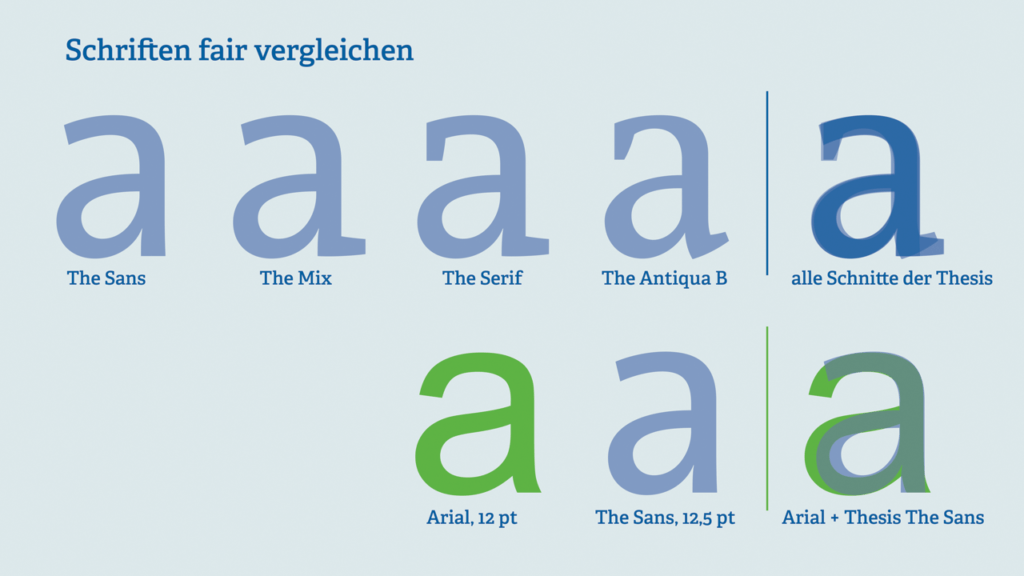
capito goes international: Our project meeting in Ireland
We traveled to Ireland to meet with our project partners for our international project “CCUV”. Learn more about it in this blog post!
Which font should you use for a text in Easy Language?
We have commissioned a study to find out which fonts contribute to legibility and comprehensibility.
There have long been recommendations on the font in which texts should be written in Easy Language. However, these recommendations are not based on scientific findings, but have arisen historically. For a long time, computers did not provide many different fonts. So there were only a few fonts to choose from, on the basis of which the recommendation for easy readability was then made.
We commissioned a study by design researcher Sabina Sieghart to find out which fonts can increase the legibility and comprehensibility of a text.
Sabina Sieghart is a designer, lecturer and design researcher. She is currently working on her doctorate at the University of Hasselt in Belgium.
The study focused on people with learning difficulties. The study participants read texts in different fonts. When selecting the fonts, the study concentrated on common fonts.
The study tested how quickly the different fonts could be read. Errors when reading aloud were also documented. At the end, the study participants were asked what they thought about the font:

Sabina Sieghart’s study provides important insights into the legibility of fonts: the results refute some common assumptions and recommendations.
For a long time, a font size of 14 pt and the font Arial were generally recommended for all texts in plain language. Thanks to Sabina Sieghart’s study, we know that this does not necessarily guarantee the best legibility.
The study shows that a font size of 14 pt is not always necessary. Smaller font sizes can sometimes even be read faster and better.
The appropriate font size also depends on the print product. In the study, 12 to 12.5 pt proved to be easily legible for print products in A5 format.
Please note that the actual size of the letters may vary depending on the font you select.
The font “Arial” is usually recommended for texts in easy language.
As part of the study, we tested the legibility of 5 fonts. The Arial font and 4 styles of the Thesis font family:
Here you can see a comparison of the tested fonts:

The surprising result: The study contradicts two common recommendations for texts in easy-to-understand language.
1. The font “Arial” is NOT particularly easy to read. Arial performed comparatively poorly in the study. Around 80 % of the other fonts were read more quickly.
2. Sans serif fonts are NOT necessarily easier to read.
Serifs are small, decorative lines attached to the ends of strokes on letters. Serifs give the font a traditional, elegant look.
Sans-serif fonts, on the other hand, have no serifs and appear more modern and minimalist, like Arial.
The study showed that sans-serif fonts are not necessarily easier to read. Some serif fonts can even be read slightly faster than sans serif fonts.
The most important finding of the study: The same principles apply to people with learning difficulties as to people without learning difficulties.
There is no one font and font size that is best readable for everyone.
Parameters that also apply when determining legibility for all target groups are decisive. Serif fonts can be just as suitable as sans serif fonts. The important thing is that they meet the legibility criteria according to DIN 1450.
The study shows that the study participants look at and evaluate the different fonts very closely. The study advises choosing the font based on the context:
For example, if a company publishes a text in easy-to-understand language, the font chosen for the corporate design can be used. The prerequisite is that the font meets the legibility criteria. In this way, the font can help to categorize texts more quickly and contribute to comprehension.
As with uniform designs, a general recommendation for a font would be problematic and could make it more difficult to understand texts in different situations.
A detailed article with statistical data is currently being published. You can already read a short version without statistics!
Are you surprised by the results of the study? Which font do you use for your texts? Share your experiences in the comments!


We traveled to Ireland to meet with our project partners for our international project “CCUV”. Learn more about it in this blog post!

In this episode, we talk with lecturer and translator Marlene Dax about Easy Language in science communication.

In this episode, we talk with cof-ounder of Com’access Karine Bardary about Easy Language in France.
capito is Italian and means “I get it.”
In the future, everyone should be able to say: “I have understood”.
+ 43 316 393 449 office@capito.eu
Headquarters
Heinrichstraße 145
8010 Graz
Austria
U.S. division
1247 Wisconsin Avenue NW Suite 201
Washington, DC 20007
USA
capito is part of the atempo group